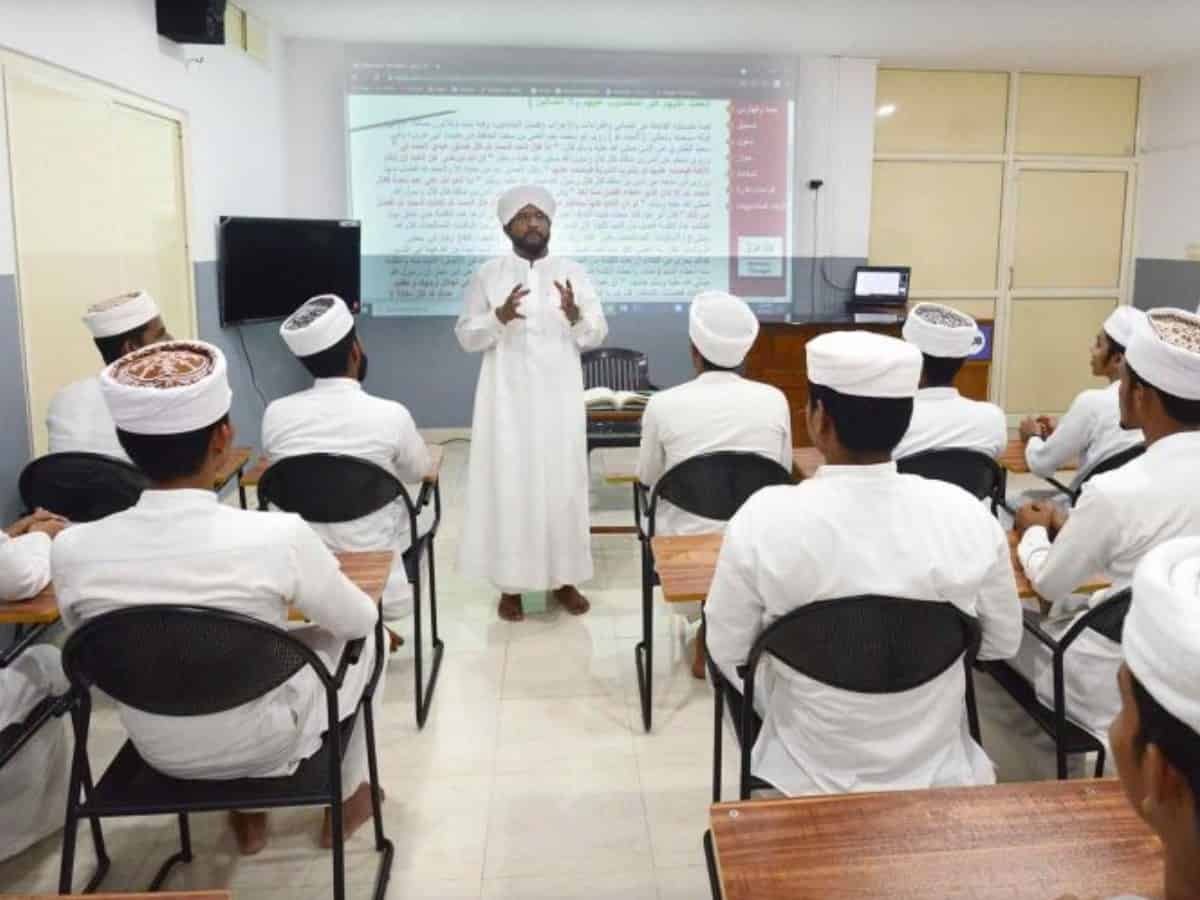
Thrissur: Students in long white robes and white head-dresses in an Islamic institution unwaveringly reciting ‘slokas’ and ‘mantras’ in Sanskrit under the watchful gaze of their Hindu gurus, is what sets apart a Muslim educational organisation in Thrissur district of central Kerala.
“Gurur brahma gurur vishnu, Gurur devo maheshwara, Gurur saakshaat param brahma, Tasmai shri gurave namaha,” one such student recites on being asked to do so in Sanskrit by his professor.
“Uttamam (excellent),” the professor responds in Sanskrit, as another student finishes reciting a different ‘sloka’ asked of him.
All conversations between the student and the professor in the class are in Sanskrit.
The objective behind teaching Sanskrit, Upanishads, Puranas, etc. is to inculcate in the students knowledge and awareness about other religions, Onampilly Muhammad Faizy, the principal of the Academy of Sharia and Advanced Studies (ASAS) run by Malik Deenar Islamic Complex (MIC), said.
Another reason, and the main one, for teaching Sanskrit to the students at MIC ASAS was Faizy’s own academic background as he had studied Shankara philosophy.
“Therefore, I felt that students should know about other religions and their customs and practices. But an in-depth study of Sanskrit as well as the ‘Upanishads’, ‘shastras’, ‘vedantams’ would not be possible during the eight-year study period,” he told PTI.
“Instead, the idea is to provide basic knowledge about these and create an awareness in them about another religion,” Faizy said.
Important portions of the Bhagavad Gita, Upanishads, Mahabharata, Ramayana are selectively taught in Sanskrit to the students over a period of eight years after they pass out of Class 10, he said.
The selective teaching of these texts is because the institution is primarily a Sharia college where other languages, like Urdu and English are also taught besides a degree course in Arts as it is affiliated to the Calicut University.
“The academic workload is huge. Therefore, we take in students who can handle it and also maintain strict standards. There is an entrance exam for admitting students,” he said.
Some of the students recently told the media that initially it was tough to learn Sanskrit, just like Arabic, but by continuously studying and practising, it becomes easier over time.
“It is a tough task initially. Just like Arabic. But if we study it continuously, repeatedly practice it, just like with Arabic, it becomes easier over a period of time. The regular classes and the tests also help us to learn it,” one of the students said.
Another student said he was excited to learn Sanskrit and hear the ‘slokas’.
Just like his classmate, he too was of the view that like Arabic, “if you put in the effort, it becomes easier to learn”.
While there has been no objection from parents of the students or anyone else, a major challenge has been finding good faculty to teach Sanskrit, the Bhagavad Gita, Upanishads, etc., properly to the students.
“That is why we were able to start teaching Sanskrit just seven years ago and it is also the reason that it is being taught only at this branch — one of seven,” principal Faizy said.
We have an excellent faculty here who have devised a good curriculum for the students, he noted.
The response from the side of the students too has been encouraging as they have shown an interest in learning Sanskrit, the principal added.
One of the faculty, professor K K Yatheendran, told media when he was invited to teach there, Faizy “was concerned whether I would have reservations about teaching in an Arabic institution as I was a Hindu”.
“I said there is no Hindu or Muslim issue here. I am coming there ready to teach. So, I have no such reservations,” he told the media.
He also said that when people see him walking toward the institute with sandalwood ’tilak’ on his forehead, they ask why I am going there.
“I tell them I am going there to teach Sanskrit and they say it is a good thing I am doing,” according to Yatheendran.
Faizy too said that he has not heard any negative or discouraging remarks from any quarter.
“Everyone who heard about it has only praised it and encouraged us,” he added.
Dr Ramesh, who also teaches Sanskrit at MIC ASAS, said that the students there have never heard of Sanskrit before coming there.
“They have not even learnt it in school. But as we move from one phase to another, the students are able to speak a little in Sanskrit, learn ‘padams’ and are able to understand some ‘slokas’ also,” according to him.
The other faculty members are Dr C M Neelakandan — retired professor of Sanskrit Literature from Sree Sankaracharya University of Sanskrit — and Dr Shamseer P C — assistant professor, department of Sanskrit, Kerala University — according to the Facebook page of MIC ASAS.
The visuals of the Sanskrit classes are also posted on the institute’s Facebook page.
At a time when political parties in Kerala are at loggerheads over alleged saffronisation of higher education institutions or them becoming centres of communism, this Islamic institution is setting an example by teaching its students Sanskrit and the Bhagavad Gita along with Arabic and the Quran.
Hafiz Aboobacker, one of the coordinators at the institute, told a media channel that it was important to learn about Islam, but knowledge about other religions was also important and that is also a reason for including Sanskrit in the syllabus.
“It would help students to learn about and understand another religion through their history and Puranas. It would also help to sync our religious views with that of theirs. It would help to create a new beginning for a new India. That is the goal behind including Sanskrit in the syllabus,” according to him.
